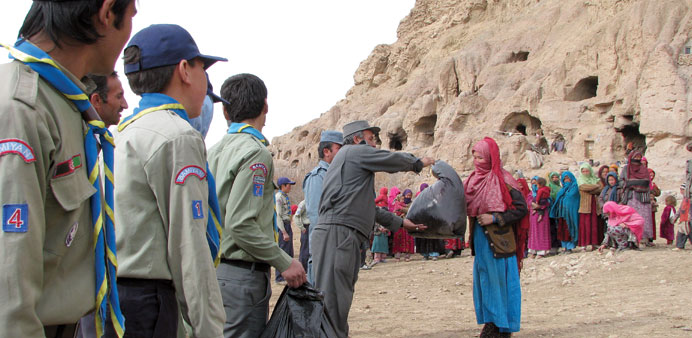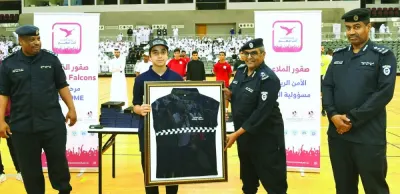Residents of the cave village of Patokhlama in Afghanistan receive the donated clothes from the United States, which were delivered by a local Scout troop.
By Jay Price
Army Major Kenton Barber never planned to hand out a truckload of warm clothes to the desperate cave-dwellers in the cliffs where the famed Bamiyan Buddhas once stood.
Nor did he plan to team up with Afghanistan’s growing Scouting movement, an aspiring Eagle Scout from Maryland, an international charity or a multiagency federal aid programme. He certainly hadn’t planned to use military planes for transport.
All he’d wanted was to put shoes and maybe a coat on a couple of the barefoot street kids he saw standing in the snow last winter outside Nato’s downtown Kabul base.
He asked his wife to collect some clothes around the house, maybe buy a few things at Wal-Mart. Nothing more grand than that.
But his wife asked neighbours in suburban Washington to help. Then one of them mentioned the informal clothing drive to Barbara Ferry, the librarian at National Geographic, whose 13-year-old son, John, was looking for an Eagle Scout project. She asked Barber to talk to him.
Last week, a year and many hurdles after Barber saw those kids in the snow, a truck loaded with bags of warm clothes, trailed by a minibus packed with Afghan Scouts, arrived at the caves. It completed John’s project. And what a project it had become.
“These Scouts, I’m very happy with them,” said Marza, whose family of six lives in a small cave and who, like many Afghans, uses just one name. “Other people never came to ask what our lives are like. But they did, and now we have clothes that will keep my children warm.”
The caves stretch for miles on either side of the empty niches where the immense Buddhas stood, before the Taliban blew them up in 2001. Most estimates put the population at several hundred families, displaced by fighting, food shortages, or just plain poverty. A 2009 survey by the Afghanistan Independent Human Rights Commission found that three-quarters of them had been there for 10 years.
Poor doesn’t begin to describe their lives, which get even harder in winter, when there are no jobs at the valley’s potato farms. That means no money for food, let alone firewood or coal, at a place 9,200ft above sea level, where the average high temperature in January is below freezing and nights often dip into the single digits or even lower. Many children sleep with sheep in their rooms to stay warm.
Marza’s cave is little bigger than a walk-in closet, the stone bare except the floor, which is covered by several rough-woven, dirty carpets. The closest thing to furniture is a shelf hacked into the rock for their few trinkets. Their luxury is a small stove, in which the family burns brush or animal dung a few times a week. Most meals are just tea and bread. If they have money for boiled potatoes, that’s a feast.
With as many as eight people crowding each cave, respiratory and intestinal problems seem universal. When dozens of residents of the cave community known as Patokhlama, just east of the Buddha niches, lined up to receive the Scouts’ bags of clothes, the chorus of coughs was non-stop. Most kids had runny noses.
Marza said her family has lived in the cave 10 years. But district school officials refuse to consider them residents, so her children can’t go to government schools, she said. Education is the only way out for her children. “I’m very sad,” she said. “I worry they will end up like us.”
Such poverty isn’t rare in Afghanistan. But Bamiyan has unusually good security, and that means the government could do much to help the cave people, but it hasn’t, said Yasin Farid, the country director for PARSA, one of Afghanistan’s oldest charities. PARSA has made ministering to the cave dwellers of Bamiyan a priority.
“The government has really wasted a chance here,” he said.
PARSA also has worked hard to re-establish Scouting in Afghanistan. And that’s how Major Barber and John Ferry came to the aid of the cave dwellers in Bamiyan.
In their first conversation — at 3am for Barber because of the time difference — Barber told John that transportation would be the hardest part of what they were discussing, but that he should go ahead with the collection, and Barber would make sure somehow that the clothes got to Afghanistan.
In early summer, John began calling schools, churches and local businesses, asking if they would host a collection bin. Then he signed up volunteers and corporate donors for things like boxes and storage, aided at times by several Scouts and Scout leaders from his unit, Scout Troop 463, in Garrett, Maryland, a town just outside Washington.
John’s collection effort was almost too successful, and Barber had to finally ask him to throttle back because they had about as much clothing as they could handle. There were 68 big boxes of clothes weighing nearly a tonne, so much that they swamped the Ferry house, and John had to arrange for donated storage.
And they had to get all those boxes to Afghanistan.
Barber knew just who to talk to: a chaplain. Chaplains have strong networks and established channels for moving donations of various kinds into war zones.
A chaplain suggested using the Denton Project, a joint operation of the State and Defence departments and the US Agency for International Development that ships humanitarian donations and equipment on a space-available basis on military cargo planes. John started the process, filling out the elaborate application form.
Still missing, however, was a local partner to clear the goods into Afghanistan. That’s when a soldier who works in Barber’s building, and is part of a group of Nato troops that support Scouts in Afghanistan, suggested Barber team up with PARSA, which readily agreed.
After two sets of federal inspections, the Boy Scouts dropped the shipment at Andrews Air Force Base in Maryland in December. Space was found on a plane bound for Germany on January 5. A couple of weeks later, a plane had space to get the clothes to Afghanistan.
Keith Blackey, PARSA’s Scouting adviser, said the group gets frequent requests to accept clothing, but ordinarily it doesn’t because of the logistics involved. But the Denton Project overcame that hurdle.
Bamiyan, where PARSA has set up two schools and employs 100 women making handicrafts, seemed the perfect destination. It also had a good-sized Scouting contingent.
Scouts in Kabul helped repack some of the boxes that had been damaged in transit. Then PARSA put them on a truck for Bamiyan. When the clothes arrived, the Scouts there sorted them, packed them in 110 plastic bags, and handed out the bags in the poor communities. And that’s how Kenton Barber’s modest idea and John Ferry’s dogged work, and the long chain of almost accidental connections, ended.
“It’s like we lucked out at every hurdle, with the right people stepping forward,” Barber said.
John was equally upbeat in a phone interview.
“One thing I learned from this is that people care and are really willing to help with a community project, if you just ask them,” he said. — MCT
Afghan charity works to revive Scouting
PARSA, the group that got the clothes collected by Maryland Boy Scout John Ferry to the cave dwellers of Bamiyan, has worked to revive Scouting in Afghanistan since 2009.
PARSA is one of the country’s oldest charities, with programmes to train teachers and social workers to deal with psychological issues in orphanages and schools, to help women start small businesses and to provide education to women and children who can’t attend traditional schools for various reasons.
It first got involved in Scouting as a way to instil values in older children it was training to help in orphanages, said Keith Blackey, PARSA’s Scouting adviser.
Now it has 2,000 Scouts and more than 100 Scout leaders spread around the county, and it’s emphasising training more Scout leaders as a way to expand Scouting.
Like most of the 181 countries with Scouting, but unlike the US, Afghan Scout troops are co-ed, and about 40% of the Scouts are girls. Boys wear long trousers and a pale green uniform shirt, and girls wear a green uniform tunic over their pants and a pale blue headscarf under their Scout cap. Both wear the usual kind of Scout activity badge, though Afghanistan being what it is, one is for Rule of Law.
Scouting in Afghanistan has a convoluted history. It started in 1931, and by 1977 it boasted 36,000 Scouts. When the Soviets invaded in 1978, they turned the programme into one for young communists. When the Taliban took over, they banned Scouting outright.
Now, despite the occasional accusation from a conservative cleric that the Scouts are campfire worshippers, the programme is growing so quickly that PARSA recently hired Blackey, a grizzled Vietnam veteran who helped restart the Scouting movement in Iraq. Blackey is the only foreigner in Afghanistan’s Scout programme; PARSA is trying to ensure that Scouting is sustainable in Afghanistan, Western help or not. — By Jay Price, MCT



